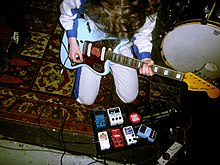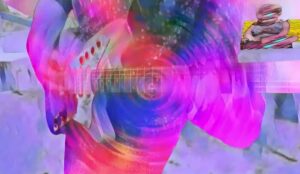What is Shoegaze music? Prepare to dive into a mesmerizing and ethereal soundscape that defines the captivating genre of Shoegaze music. With its dreamy textures, swirling guitars, and hazy vocals, Shoegaze music emerged as a unique and influential movement in the alternative rock scene during the late 1980s and early 1990s.
Shoegaze music is characterized by its dense and layered sound, marked by heavily distorted guitars, lush effects, and ethereal melodies. The name “Shoegaze” originated from the performers’ tendency to stare down at their guitar pedals while performing, creating a distinct visual aesthetic.
The genre is known for its emphasis on creating an immersive sonic experience, where the music envelopes the listener in a wall of sound, blurring the boundaries between the instruments and vocals. With its roots in the United Kingdom, Shoegaze bands such as My Bloody Valentine, Slowdive, and Ride became pioneers of the genre, pushing the boundaries of traditional rock music.
Shoegaze music often incorporates elements of noise, feedback, and intricate guitar layering to create a mesmerizing sonic tapestry. The vocals in Shoegaze tend to be soft and ethereal, blending with the atmospheric instrumentation to create a dreamlike ambiance. The impact of Shoegaze music extends beyond its initial emergence, influencing subsequent generations of alternative, indie, and experimental artists.
What is the definition of Shoegaze music?
Shoegaze is a music genre that emerged in the late 1980s and early 1990s, primarily in the United Kingdom. It is characterized by its dense and heavily textured sound, often featuring layers of distorted guitars, ethereal vocals, and prominent use of effects such as reverb, delay, and feedback.
The term “shoegaze” itself is derived from the performers’ tendency to stare down at their effects pedals or their shoes while playing, engrossed in creating the atmospheric and dreamy soundscapes.
Shoegaze music typically incorporates elements of alternative rock, noise pop, and psychedelic rock. The genre often emphasizes mood and atmosphere over traditional song structures and lyrical content.
The vocals are often hushed and buried in the mix, blending with the instrumentation to create a wall of sound. The lyrics often explore introspective and introspective themes, with an emphasis on introspection, dreamlike imagery, and emotional expression.
Some influential shoegaze bands include My Bloody Valentine, Ride, Slowdive, Lush, and Cocteau Twins. While the initial wave of shoegaze was relatively short-lived, its influence can be heard in subsequent genres such as dream pop, post-rock, and indie rock.
How did Shoegaze music get its name?
The term “shoegaze” was coined by the British music press in the late 1980s as a somewhat derogatory label for a group of bands that often appeared on stage immersed in their own music, seemingly staring down at their effects pedals or their shoes rather than actively engaging with the audience.
This introspective and detached stage presence became a defining characteristic of the shoegaze scene.
The name “shoegaze” itself was first used by the British music journalist Andy Ross in a review of a concert by the band Moose. Ross described their performance as “a mesmerizing, droning wall of sound, music for the eyes rather than the feet: Shoegazing” in reference to their lack of movement on stage. The term caught on and began to be used more widely to describe the emerging genre.
While initially intended as a criticism, the term “shoegaze” eventually became adopted by the bands themselves and their fans. It has since become a recognized and accepted term to describe the genre, even though it originally referred more to the performance style than the musical characteristics of the bands.
What are the key characteristics of Shoegaze music?
Shoegaze music is characterized by several key elements that contribute to its distinct sound and atmosphere. Here are some of the main characteristics:
- Wall of Sound: Shoegaze is known for its dense and layered soundscapes. Guitars are often heavily distorted and drenched in effects such as reverb, delay, and feedback, creating a wall of sound that envelops the listener.
- Ethereal Vocals: The vocals in shoegaze are typically ethereal and dreamy, often buried within the mix and treated with effects. The lyrics are often introspective and abstract, adding to the atmospheric and otherworldly feel of the music.
- Effects and Textures: Shoegaze heavily relies on the use of effects pedals and production techniques to create unique sonic textures. This includes the use of tremolo, chorus, phasers, and other modulation effects, as well as ambient washes of sound and intricate guitar layering.
- Melodic Pop Sensibilities: Despite its dense and noisy sound, shoegaze often incorporates melodic pop sensibilities. Catchy melodies and hooks can be found within the layers of guitars and effects, providing a contrast to the wall of sound.
- Atmosphere and Mood: Shoegaze music is highly focused on creating a specific atmosphere and mood. It often evokes a dreamlike or introspective quality, with a sense of emotional depth and longing.
- Non-Traditional Song Structures: Shoegaze tends to deviate from traditional song structures, with extended instrumental sections, gradual build-ups, and an emphasis on textures and dynamics rather than strict verse-chorus formats.
- Influences from Alternative and Psychedelic Rock: Shoegaze draws influences from various genres, particularly alternative rock and psychedelic rock. The blend of noise, distortion, and dreamy textures is reminiscent of the experimental and psychedelic elements found in these genres.
Notable shoegaze bands such as My Bloody Valentine, Ride, Slowdive, Lush, and Cocteau Twins exemplify these characteristics and have contributed significantly to shaping the genre.
Who were the pioneers of Shoegaze music?
The pioneers of shoegaze music were a group of bands that emerged in the late 1980s and early 1990s primarily in the United Kingdom. These bands were instrumental in developing the distinctive sound and style of the genre. Here are some of the key pioneers of shoegaze:
- My Bloody Valentine: Considered one of the most influential shoegaze bands, My Bloody Valentine’s album “Loveless” (1991) is often regarded as a landmark in the genre. Their innovative use of guitar effects, layered textures, and hushed vocals set the template for many shoegaze bands that followed.
- Cocteau Twins: While not strictly a shoegaze band, the Cocteau Twins’ dreamy and atmospheric sound had a significant influence on the genre. Their ethereal vocals, swirling guitars, and use of effects helped shape the sonic landscape of shoegaze.
- Ride: Ride’s debut album “Nowhere” (1990) is considered a classic of shoegaze. Their blend of distorted guitars, catchy melodies, and hazy atmospheres encapsulated the essence of the genre. They were known for their dynamic song structures and energetic live performances.
- Slowdive: Slowdive’s music often featured dreamy vocals, intricate guitar layering, and an emphasis on atmospheric soundscapes. Their albums “Just for a Day” (1991) and “Souvlaki” (1993) are considered seminal shoegaze releases.
- Lush: Lush combined elements of shoegaze with pop sensibilities, creating a sound that was melodic and accessible. Their album “Split” (1994) showcased their knack for blending distorted guitars with catchy hooks and lush harmonies.
These bands, among others, laid the foundation for shoegaze music and influenced subsequent generations of artists. Their innovative use of effects, textured soundscapes, and dreamy atmospheres helped define the genre’s signature characteristics.
How does Shoegaze music differ from other genres like alternative rock or dream pop?
Shoegaze music, alternative rock, and dream pop share some similarities but also have distinct characteristics that set them apart from each other. Here are some differences between shoegaze, alternative rock, and dream pop:
Sound and Texture:
- Shoegaze: Shoegaze is characterized by its dense, layered, and heavily distorted soundscapes. It often employs extensive use of effects like reverb, delay, and feedback to create a wall of sound.
- Alternative Rock: Alternative rock encompasses a broad range of styles, but generally, it has a more guitar-driven and straightforward sound compared to shoegaze. It can be characterized by a rawer, grittier, and more energetic approach.
- Dream Pop: Dream pop typically features softer, ethereal, and more delicate soundscapes. It focuses on creating dreamy, atmospheric textures, often with a lighter touch of distortion or effects.
Vocal Style:
- Shoegaze: Shoegaze vocals are often ethereal, dreamy, and hushed, blending with the instrumentation to create a cohesive wall of sound. The lyrics may be introspective and abstract.
- Alternative Rock: Alternative rock vocals can vary widely, but they often exhibit more upfront and prominent delivery. They can range from gritty and raw to melodic and expressive.
- Dream Pop: Dream pop vocals are typically airy, gentle, and floating. They often emphasize dreamlike melodies and evoke a sense of reverie and introspection.
Song Structures and Melodies:
- Shoegaze: Shoegaze tends to deviate from traditional song structures, with extended instrumental sections and a focus on textures and dynamics. Melodies can be buried within the layers of sound.
- Alternative Rock: Alternative rock generally follows more conventional song structures, with verses, choruses, and bridges. Melodies and hooks are often more upfront and catchy.
- Dream Pop: Dream pop often incorporates catchy melodies and accessible song structures. It places a stronger emphasis on pop sensibilities while still maintaining an ethereal and atmospheric quality.
Influence and Origins:
- Shoegaze: Shoegaze emerged in the late 1980s and early 1990s, primarily in the UK. It was influenced by alternative rock, noise pop, and psychedelic rock.
- Alternative Rock: Alternative rock originated in the 1980s as a response to mainstream rock, encompassing various subgenres like grunge, indie rock, and post-punk. It draws influence from punk, garage rock, and new wave, among others.
- Dream Pop: Dream pop originated in the 1980s and drew influences from various genres like post-punk, ethereal wave, and ambient music. It emphasizes atmosphere, dreaminess, and introspective qualities.
While there can be overlaps and blurred lines between these genres, these distinctions help highlight the unique characteristics and sonic approaches of shoegaze, alternative rock, and dream pop.
What are the typical instruments used in Shoegaze music?
Shoegaze music typically involves a range of instruments that contribute to its distinctive sound. Here are the typical instruments used in shoegaze:
- Electric Guitars: Electric guitars play a central role in shoegaze. They are often heavily distorted and layered to create a dense and textured wall of sound. Guitarists in shoegaze bands frequently employ effects pedals, such as reverb, delay, tremolo, and feedback, to shape their unique sonic palette.
- Bass Guitar: The bass guitar provides the low-end foundation in shoegaze music. It helps create the thick and resonant layers of sound, adding depth and weight to the overall texture.
- Drums: Drums play a crucial role in driving the rhythm and dynamics of shoegaze music. They provide the backbone and establish the pulse of the songs. Shoegaze drumming can range from steady and driving beats to more intricate and textured patterns.
- Keyboards/Synthesizers: While not as prevalent as guitars, keyboards and synthesizers are sometimes used in shoegaze to add atmospheric elements and additional layers of sound. They can contribute to the dreamy and ethereal qualities of the music.
- Effects Pedals: Shoegaze musicians heavily rely on effects pedals to shape their sound. Various types of pedals, including distortion, overdrive, reverb, delay, chorus, and tremolo, are commonly used to create the signature shoegaze textures and washes of sound.
- Vocals: Vocals in shoegaze music can be soft, ethereal, and buried within the mix. The singing style often blends with the overall instrumentation, becoming another layer of the sonic tapestry.
It’s important to note that while these instruments are typical in shoegaze, the specific lineup and instrumentation can vary from band to band. Some shoegaze bands may incorporate additional instruments or experiment with unconventional sounds to further expand the sonic possibilities of the genre.
How does the use of effects and distortion shape the sound of Shoegaze music?
The use of effects and distortion is a crucial aspect of shaping the distinctive sound of shoegaze music. Here’s how effects and distortion contribute to the sonic character of shoegaze:
- Wall of Sound: Shoegaze is known for its dense and layered soundscapes, and effects play a significant role in creating this “wall of sound.” By applying effects like reverb, delay, and feedback, the sound becomes expansive and enveloping, filling the sonic space and immersing the listener in a rich and textured experience.
- Textures and Atmosphere: Effects pedals allow shoegaze musicians to experiment with various sonic textures, adding depth, complexity, and atmosphere to the music. Reverb and delay, in particular, are extensively used to create a sense of space and a dreamy, ethereal quality. The combination of different effects can produce swirling, shimmering, and cascading sounds that contribute to the otherworldly atmosphere of shoegaze.
- Sustain and Decay: Distortion is a key component in shaping the sustain and decay characteristics of shoegaze. By using distortion pedals and overdriven amplifiers, guitarists can achieve extended sustain and feedback, allowing notes and chords to ring out and blend together. This creates a sense of continuous sound and contributes to the immersive and enveloping nature of shoegaze music.
- Emphasis on Texture over Clarity: In shoegaze, the focus is often on creating a wall of sound rather than emphasizing individual clarity of instruments or vocals. Distortion can blur the lines between different elements, such as guitars, bass, and vocals, blending them together and creating a cohesive and textured sonic landscape.
- Sonic Exploration and Creativity: The use of effects and distortion in shoegaze encourages sonic experimentation and creativity. Musicians can push the boundaries of conventional guitar sounds and manipulate the timbre, dynamics, and spatial characteristics of their instruments. This allows for the creation of unique and evocative sonic palettes that define the shoegaze genre.
What are the lyrical themes commonly found in Shoegaze music?
Shoegaze music is known for its atmospheric and introspective qualities, and the lyrical themes often align with these characteristics. While individual bands may explore a range of topics, here are some common lyrical themes found in shoegaze music:
- Introspection and Self-Reflection: Many shoegaze songs delve into introspective themes, exploring one’s inner thoughts, emotions, and personal experiences. The lyrics may touch upon feelings of longing, confusion, self-discovery, and introspective journeys.
- Relationships and Love: Love and relationships are recurring themes in shoegaze music. The lyrics often convey a sense of yearning, longing, or desire. They can explore the complexities of romantic relationships, emotional connections, or even the pain of heartbreak.
- Dreamlike Imagery: Shoegaze lyrics often employ dreamlike and abstract imagery. They may paint vivid and evocative scenes, using metaphorical language and poetic imagery to convey emotions and experiences. The lyrics can transport the listener into a dreamy, ethereal realm.
- Existentialism and Philosophy: Some shoegaze songs touch upon existential themes, questioning the meaning of life, identity, and existence. These lyrics may delve into philosophical and existential ponderings, exploring the human condition and the search for purpose and truth.
- Nature and Landscape: The natural world and its imagery often find their way into shoegaze lyrics. References to landscapes, seasons, elements of nature, and the beauty of the natural world contribute to the atmospheric and contemplative tone of the genre.
- Escapism and Transcendence: Shoegaze lyrics can evoke a sense of escapism and transcendence. They may express a desire to escape from mundane realities or seek solace and liberation in music, dreams, or altered states of consciousness.
It’s important to note that while these themes are commonly found in shoegaze music, not all songs adhere to them exclusively. The lyrical content in shoegaze can vary widely, reflecting the individual perspectives and artistic expressions of different bands and songwriters within the genre.
How did Shoegaze music emerge and evolve over time?
Shoegaze music emerged in the late 1980s and early 1990s primarily in the United Kingdom. Its origins can be traced back to the blending of alternative rock, noise pop, and psychedelic rock influences. Here’s a timeline of the emergence and evolution of shoegaze:
Late 1980s:
- Bands such as The Jesus and Mary Chain and Cocteau Twins laid the groundwork for shoegaze with their use of atmospheric textures, hazy guitars, and ethereal vocals.
- The term “shoegaze” was coined by the music press, referencing the bands’ onstage tendency to stare down at their shoes or effects pedals during performances.
Early 1990s:
- The emergence of key shoegaze bands propelled the genre forward. Bands like My Bloody Valentine, Ride, Slowdive, and Lush released influential albums that defined the sound and aesthetics of shoegaze.
- My Bloody Valentine’s album “Loveless” (1991) is often considered a landmark shoegaze release, characterized by its dense layers of guitars, swirling textures, and ethereal vocals.
- Ride’s album “Nowhere” (1990) and Slowdive’s albums “Just for a Day” (1991) and “Souvlaki” (1993) further contributed to the genre’s development with their melodic sensibilities and immersive soundscapes.
Mid to Late 1990s:
- Shoegaze experienced a decline in popularity by the mid-1990s as grunge and Britpop gained mainstream attention. Many shoegaze bands disbanded or shifted their musical directions.
- Some bands incorporated electronic and experimental elements into their sound, transitioning into other genres like electronic rock, post-rock, or trip-hop.
2000s and Beyond:
- Despite the decline in popularity, shoegaze continued to have a devoted fan base and inspired subsequent generations of musicians.
- Shoegaze influences began to resurface in the 2000s, with the emergence of bands like The Pains of Being Pure at Heart, Deerhunter, and DIIV incorporating shoegaze elements into their indie rock sound.
- Shoegaze experienced periodic revivals and renewed interest, with new bands embracing the genre’s aesthetic and sound.
In recent years, shoegaze has seen a resurgence in popularity, with both newer and established bands embracing its sound. The genre continues to evolve, with artists blending shoegaze elements with other genres and incorporating modern production techniques.
What are some influential Shoegaze bands and artists?
There have been several influential shoegaze bands and artists that have shaped the genre and left a lasting impact on the music landscape. Here are some of the most notable and influential shoegaze acts:
- My Bloody Valentine: My Bloody Valentine is widely regarded as one of the most influential shoegaze bands. Their album “Loveless” (1991) is considered a seminal shoegaze release, known for its dense layers of guitars, innovative production techniques, and ethereal vocals.
- Ride: Ride was a key shoegaze band, known for their melodic sensibilities and dynamic sound. Their debut album “Nowhere” (1990) is considered a classic in the genre and features a balance of shoegaze noise and catchy pop melodies.
- Slowdive: Slowdive’s dreamy and atmospheric sound made them an important shoegaze band. Their albums “Just for a Day” (1991) and “Souvlaki” (1993) showcase their ethereal vocals, lush guitar textures, and introspective songwriting.
- Lush: Lush blended shoegaze with pop sensibilities, creating a sound that was both accessible and atmospheric. Their album “Split” (1994) is regarded as a significant shoegaze release, featuring catchy melodies and layered guitars.
- Cocteau Twins: While not strictly a shoegaze band, the Cocteau Twins’ ethereal and dreamy sound heavily influenced the genre. Their unique vocals, atmospheric guitars, and poetic lyrics played a significant role in shaping shoegaze.
- Swervedriver: Swervedriver combined shoegaze with elements of alternative rock and heavy guitar-driven sound. Their albums “Raise” (1991) and “Mezcal Head” (1993) showcase their energetic and noisy approach to shoegaze.
- Chapterhouse: Chapterhouse blended shoegaze with elements of dance and electronic music, incorporating pulsating rhythms and atmospheric textures. Their album “Whirlpool” (1991) is a notable release in the genre.
- The Jesus and Mary Chain: While not strictly shoegaze, The Jesus and Mary Chain’s blend of noise pop and atmospheric rock heavily influenced the genre’s development with their feedback-drenched guitars and catchy melodies.
How has Shoegaze music influenced other genres and contemporary music?
Shoegaze music has had a significant impact on other genres and contemporary music. Its unique blend of dense textures, dreamy atmospheres, and sonic experimentation has influenced and inspired musicians across various genres.
Here are some ways in which shoegaze has influenced other genres and contemporary music:
- Dream Pop: Dream pop is a genre that draws heavily from shoegaze. It emphasizes ethereal vocals, atmospheric soundscapes, and introspective lyrics. Many dream pop bands incorporate elements of shoegaze’s textural and atmospheric qualities into their music, creating a dreamy and contemplative sonic palette.
- Post-Rock: Shoegaze’s emphasis on textures, atmosphere, and experimental soundscapes has had a strong influence on post-rock. Post-rock bands often employ similar techniques of layering guitars, creating expansive soundscapes, and incorporating elements of noise and ambient music.
- Indie Rock: Shoegaze’s impact on indie rock can be heard in the use of textured guitars and atmospheric elements. Many contemporary indie rock bands incorporate shoegaze-inspired guitar effects and hazy textures, adding a dreamy and immersive quality to their sound.
- Alternative and Indie Pop: Shoegaze’s influence can also be heard in alternative and indie pop music. Artists often incorporate shoegaze-inspired guitar tones and effects to add depth and texture to their pop-oriented songs. This blending of catchy melodies with shoegaze aesthetics creates a unique and atmospheric pop sound.
- Experimental and Noise Music: Shoegaze’s exploration of sonic experimentation, feedback, and noise has influenced experimental and noise musicians. The genre’s willingness to push the boundaries of traditional song structures and embrace unconventional sounds has informed the experimental and noise music scenes.
- Revivals and Contemporary Shoegaze: Shoegaze has experienced periodic revivals and renewed interest since its inception. Many contemporary bands draw inspiration directly from the original shoegaze era, incorporating its signature sounds and aesthetics into their music. These bands help keep the shoegaze spirit alive and introduce it to new audiences.
What are some notable Shoegaze albums that have made an impact?
There are several notable shoegaze albums that have made a significant impact on the genre and beyond. These albums showcase the unique qualities and sonic innovations of shoegaze music. Here are some of the most influential and impactful shoegaze albums:
- My Bloody Valentine – “Loveless” (1991): Considered a landmark shoegaze release, “Loveless” is revered for its dense layers of guitars, intricate production techniques, and ethereal vocals. It has had a lasting influence on shoegaze and alternative music as a whole.
- Slowdive – “Souvlaki” (1993): Slowdive’s second album, “Souvlaki,” is widely regarded as a classic in the genre. It showcases dreamy textures, emotive vocals, and atmospheric soundscapes, capturing the essence of shoegaze.
- Ride – “Nowhere” (1990): Ride’s debut album, “Nowhere,” is a defining shoegaze record. It features a blend of energetic rock and dreamy pop melodies, with layered guitars and catchy hooks.
- Lush – “Split” (1994): Lush’s “Split” combines elements of shoegaze with accessible pop sensibilities. It features lush harmonies, shimmering guitars, and a balance between melodic hooks and atmospheric soundscapes.
- Cocteau Twins – “Heaven or Las Vegas” (1990): While not strictly shoegaze, the Cocteau Twins’ album “Heaven or Las Vegas” has had a profound influence on the genre. Their ethereal vocals, swirling guitars, and dreamlike atmospheres have inspired many shoegaze artists.
- Swervedriver – “Raise” (1991): Swervedriver’s debut album, “Raise,” blends shoegaze with alternative rock and showcases their heavy and energetic guitar-driven sound. It exemplifies the dynamic and noisy side of shoegaze.
- Chapterhouse – “Whirlpool” (1991): Chapterhouse’s debut album, “Whirlpool,” is known for its swirling guitars, hazy atmospheres, and melodic sensibilities. It contributed to the shoegaze scene with its blend of pop hooks and textured soundscapes.
- Pale Saints – “The Comforts of Madness” (1990): Pale Saints’ debut album, “The Comforts of Madness,” features a combination of distorted guitars, ethereal vocals, and introspective lyrics. It represents the introspective and atmospheric side of shoegaze.
These albums have played a crucial role in defining the shoegaze genre and continue to be highly regarded for their innovation, sonic exploration, and lasting influence on subsequent generations of musicians.
How does Shoegaze music create a unique atmospheric and immersive experience for listeners?
Shoegaze music creates a unique atmospheric and immersive experience for listeners through several key elements:
- Layered Textures: Shoegaze is characterized by its dense and layered textures. Multiple guitars, often heavily distorted and drenched in effects, are intricately layered, creating a rich and multidimensional sonic landscape. These layers blend together, forming a cohesive and enveloping wall of sound that surrounds the listener.
- Sonic Depth and Space: Shoegaze music often incorporates elements like reverb, delay, and feedback to create a sense of space and depth. The use of these effects enhances the perceived distance and reverberation of the instruments, creating a spacious and expansive sonic environment. The music can envelop the listener, as if immersed in a sonic haze.
- Ethereal Vocals: Shoegaze vocals often have an ethereal quality, with singers delivering hushed, dreamy, and often buried vocals. The vocals become another layer of the instrumentation, blending with the guitars and effects, further contributing to the immersive and atmospheric nature of the music.
- Dynamic Range: Shoegaze frequently utilizes dynamics to heighten the atmospheric experience. Soft and gentle passages may transition into intense walls of sound, creating a contrast that enhances the emotional impact and intensity of the music. These dynamic shifts contribute to the immersive and captivating nature of the genre.
- Emotional Expressiveness: Shoegaze music often explores introspective and introspective themes, conveying a wide range of emotions. The combination of layered textures, ethereal vocals, and atmospheric qualities creates a sense of emotional depth and resonance, allowing listeners to connect with and be swept away by the music on an emotional level.
- Repetitive and Hypnotic Patterns: Shoegaze can incorporate repetitive and hypnotic patterns, often through the use of guitar loops or pulsating rhythms. These patterns, combined with the immersive soundscapes, can create a mesmerizing and trance-like effect, drawing listeners into a meditative state and further enhancing the atmospheric experience.
Collectively, these elements work together to create a distinct atmosphere and immerse the listener in a sonic journey. Shoegaze’s unique combination of textures, space, vocals, dynamics, emotional expression, and hypnotic qualities contributes to its ability to captivate and transport listeners to a dreamy and immersive sonic world.
What are some common misconceptions or stereotypes about Shoegaze music?
Shoegaze music has often been misunderstood or subject to certain misconceptions and stereotypes. Here are some common misconceptions about shoegaze:
- Lack of Energy or Emotion: One misconception is that shoegaze is devoid of energy or emotional depth. While shoegaze can have a dreamy and introspective quality, it is not necessarily synonymous with being passive or detached. Shoegaze can evoke a wide range of emotions, from intense and overwhelming to melancholic and introspective, creating a powerful and immersive sonic experience.
- Lack of Variety or Song Structures: Another misconception is that shoegaze is monotonous or lacks variety in its song structures. While the genre often deviates from traditional verse-chorus structures, shoegaze encompasses a range of approaches and sounds. It can include dynamic shifts, intricate arrangements, and melodic hooks, showcasing a diverse sonic landscape within the genre.
- All Shoegaze Bands Sound the Same: Shoegaze has a distinct sonic identity, but it would be inaccurate to suggest that all shoegaze bands sound identical. Within the genre, there is a wide spectrum of sounds, from more noisy and chaotic bands to those with a more delicate and melodic approach. Shoegaze encompasses a variety of styles and artistic expressions.
- Limited Innovation or Relevance: Some may perceive shoegaze as a genre stuck in the past or lacking innovation. However, shoegaze has continued to evolve and influence contemporary music. It has inspired artists across various genres and continues to have an impact on the sonic experimentation and atmospheric qualities found in modern music.
- Shoegaze is Only About Effects and Guitars: While effects and guitars play a significant role in shoegaze, it is not solely defined by these elements. Shoegaze encompasses a broader approach to music that includes atmospheric textures, introspective lyrics, vocal stylings, and the overall sonic experience. It is a genre that encompasses a variety of sonic and creative elements.
What are the current trends and developments in the Shoegaze music scene?
Shoegaze is a genre of rock music that emerged in the early 1990s. It is characterized by its use of heavily distorted guitars, reverb, and delay effects, creating a wall of sound that is often described as “dreamy” or “ethereal.”
In recent years, there has been a resurgence of interest in shoegaze music. This has led to the development of new trends and developments in the genre.
One of the most notable trends is the use of more electronic elements in shoegaze music. This is evident in the work of bands like Nothing, Slowdive, and MBV, who have incorporated elements of electronica, ambient music, and even hip hop into their sound.
Another trend is the focus on vocals. In the early days of shoegaze, vocals were often buried in the mix. However, modern shoegaze bands are placing more emphasis on vocals, which are often used to create a sense of atmosphere or emotion.
Finally, there is a renewed interest in the DIY ethic that was prevalent in the early days of shoegaze. Many modern shoegaze bands are self-releasing their music and touring independently. This has helped to create a more vibrant and diverse shoegaze scene.
Here are some of the current trends and developments in the shoegaze music scene:
- The use of more electronic elements
- The focus on vocals
- The renewed interest in the DIY ethic
- The emergence of new subgenres, such as dream pop and ambient shoegaze
- The collaboration between shoegaze bands and other genres, such as indie rock, post-rock, and electronica
The shoegaze scene is constantly evolving, and it will be interesting to see what new trends emerge in the years to come.
Conclusion
What is Shoegaze music? Shoegaze music is a genre that emerged in the late 1980s and early 1990s, primarily in the United Kingdom. It is characterized by its dense and textured soundscapes, incorporating heavily distorted guitars, ethereal vocals, and prominent use of effects such as reverb, delay, and feedback.
Shoegaze music often emphasizes mood, atmosphere, and introspection over traditional song structures, creating a dreamy and immersive sonic experience. Influential bands like My Bloody Valentine, Slowdive, and Ride have shaped the genre, leaving a lasting impact on contemporary music.






